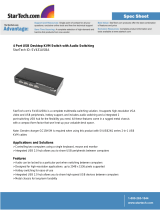6
2- AND 4-PORT SERVSWITCH DT PRO II
1. Specifications
Resolution: 2048 x 1536
Supported Operating Systems: Windows
®
98/Me/2000/XP and Windows NT
®
,
Linux
®
, NetWare
®
, Mac OS
®
Hotkeys: Yes
User Controls: KV7020A: (2) port selection buttons;
KV7021A: (4) port selection buttons
Connectors: KV7020A: Computer end: PS/2
®
keyboard, PS/2 mouse, VGA Video:
(2) HD15 female,
USB keyboard, mouse, and peripherals: (2) USB Type B female,
Microphones/speakers: (4) 3.5-mm jacks;
Console end: Keyboard: (1) 6-pin mini-DIN female or (1) USB Type A female,
Mouse: (1) 6-pin mini-DIN female or (1) USB Type A female,
Monitor: (1) HD15 female,
USB peripherals: (2) USB Type A female,
Microphone/speaker: (2) 3.5-mm jacks,
Power: (1) barrel connector;
KV7021A: Computer end: PS/2 keyboard, PS/2 mouse, and VGA video:
(4) HD15 female,
USB keyboard, mouse, and peripherals: (4) USB Type B female,
Microphones/speakers: (8) 3.5-mm jacks;
Console end: Keyboard: (1) 6-pin mini-DIN female or (1) USB Type A female,
Mouse: (1) 6-pin mini-DIN female or (1) USB Type A female,
Monitor: (1) HD15 female,
USB peripherals: (2) USB Type A female,
Microphone/speaker: (2) 3.5-mm jacks,
Power: (1) barrel connector
Indicators: KV7020A: (2) Port LEDs, (2) Hub LEDs;
KV7021A: (4) Port LEDs, (4) Hub LEDs
Temperature Tolerance: Operating: 32 to 104°F (0 to 40°C);
Storage: -4 to +140°F (-20 to +60°C)
Relative Humidity: Up to 80%, noncondensing





















